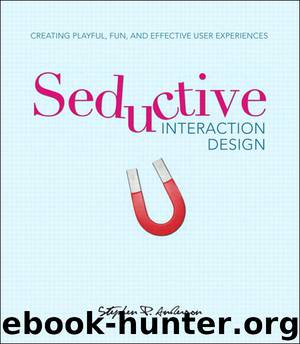Seductive Interaction Design (Joanne Romanovich's Library) by Stephen P. Anderson

Author:Stephen P. Anderson
Language: eng
Format: epub
Publisher: New Riders
Published: 2011-10-08T16:00:00+00:00
* * *
What is Behavioral Economics?
Many of the ideas in this section come from the field of “behavioral economics,” which explores ways that social, cognitive, and emotional factors influence economic decisions. Traditional economic theory is based on the idea that people make rational decisions; however, a number of studies, dating back to the early 1950s, demonstrate that we often make inconsistent and irrational decisions. As an example, consider how you might respond to the following scenarios:
Scenario A:
You live around the corner from an electronics store that carries the new computer speakers you’ve been looking at for $100. You also learn that a discounter, located ten miles from your house, has a special on the same speakers for half price: $50. Do you drive the ten miles?
Scenario B:
You live near an electronics store that carries the new computer you’ve wanted for $2000. Ten miles from your house, another store is carrying the same computer for $1950... a savings of $50. Do you drive the ten miles?
The question posed in each scenario is essentially the same: Do you drive ten miles to save 50 dollars? Most people respond “yes” to the first question, but “no” to the second. All that’s changed is how the question is presented, which demonstrates an idea central to behavioral economics: the way a scenario is worded influences the decision of the respondent.
While some people may make rational decisions, it’s more likely we make decisions based on things such as:
• available information (also known as bounded rationality)
• heuristics and biases (mental shortcuts to help us make safe decisions quickly)
• how a question is presented (also know as a frame)
If you’ve ever heard about studies where researchers secretly changed the labels on wine bottles, or explored what happens when you add higher priced options—those are popular examples from behavioral economics. The studies are varied, and explore such things as how we react to multiple choices, the influence of others, near-term vs. long-term decisions, how we rely too much on one piece of information (anchor), ways to exploit gaps in perception and attention, the changing state of memory, and related topics.
Many of the conclusions from all these different studies can be summarized as follows:
• We are not very good at making long-term decisions.
• We are better at understanding relative rather than absolute values.
• Emotion or affect influences our behaviors.
• We are very bad at predicting what will make us happy, and we are even bad at describing what made us happy in the first place.
Some of these studies are described here in detail. For more information, I’d recommend starting with a book like Predictably Irrational by Dan Ariely, or Nudge by Richard Thaler & Cass Sunstein.
Download
This site does not store any files on its server. We only index and link to content provided by other sites. Please contact the content providers to delete copyright contents if any and email us, we'll remove relevant links or contents immediately.
| Coding Theory | Localization |
| Logic | Object-Oriented Design |
| Performance Optimization | Quality Control |
| Reengineering | Robohelp |
| Software Development | Software Reuse |
| Structured Design | Testing |
| Tools | UML |
Deep Learning with Python by François Chollet(12858)
Hello! Python by Anthony Briggs(10116)
The Mikado Method by Ola Ellnestam Daniel Brolund(10005)
OCA Java SE 8 Programmer I Certification Guide by Mala Gupta(9976)
Dependency Injection in .NET by Mark Seemann(9511)
Algorithms of the Intelligent Web by Haralambos Marmanis;Dmitry Babenko(8517)
Grails in Action by Glen Smith Peter Ledbrook(7877)
Test-Driven iOS Development with Swift 4 by Dominik Hauser(7845)
The Well-Grounded Java Developer by Benjamin J. Evans Martijn Verburg(7762)
Becoming a Dynamics 365 Finance and Supply Chain Solution Architect by Brent Dawson(7673)
Microservices with Go by Alexander Shuiskov(7431)
Practical Design Patterns for Java Developers by Miroslav Wengner(7354)
Test Automation Engineering Handbook by Manikandan Sambamurthy(7297)
Angular Projects - Third Edition by Aristeidis Bampakos(6718)
Secrets of the JavaScript Ninja by John Resig Bear Bibeault(6628)
The Art of Crafting User Stories by The Art of Crafting User Stories(6215)
NetSuite for Consultants - Second Edition by Peter Ries(6160)
Demystifying Cryptography with OpenSSL 3.0 by Alexei Khlebnikov(5973)
Kotlin in Action by Dmitry Jemerov(5291)
